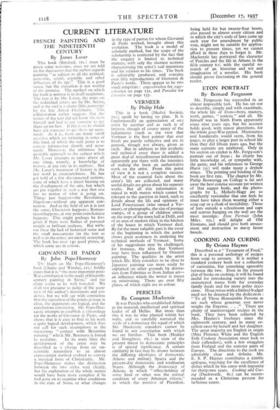VERMEER By Philip Hale This is a book (Medici Society,
2 is.) spoilt by having no plan.' It is fundamentally an appreciation of one artist by another and as such is of interest, though of course many of the judgements (such as the view that Vermeer is the best painter that ever lived) are purely subjective and are in general, though not always, given as such. But in addition to this aesthetic and technical essay there is added a great deal of miscellaneous information, apparently put there with the intention of making the book an authoritative work on the artist. From this point of view it is not a complete success. Most of the essential facts about the artist's life are collected, and many useful details are given about his separate works. But all this information is mixed in with matter which cannot be relevant to the question in hand, such as details about the life and opinions of Lord Powerscourt (who owned a Ver- meer), or photographs, the size of postage stamps, of a group of children sitting on the steps of the town hall at Delft, and of an area of modern tiling in the kitchen of the house in which Vermeer died. By far the most valuable part is the essay at the beginning in which the author shows great acuteness in analysing the technical methods of Vermeer. Some of his suggestions may be challenged, for instance, the idea that Vermeer may have been influenced by Oriental painting. The qualities in the artist which Mr. Hale considers to be close to Japanese painting can more easily be explained on other grounds by deriva- tion from Fabritius or from Italian art— an influence which the writer is intent on minimising. There are over fifty plates, of which eight are in colour.














































 Previous page
Previous page